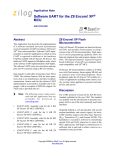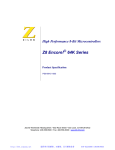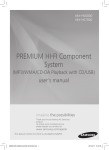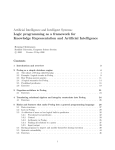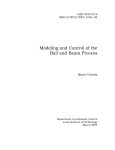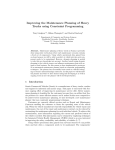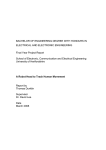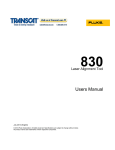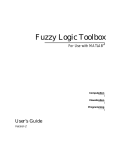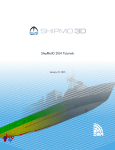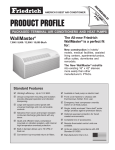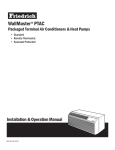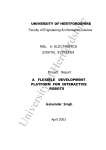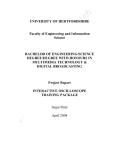Download University of Hertfordshire
Transcript
i re
dsh
UNIVERSITY OF HERTFORDSHIRE
fo r
Faculty of Engineering & Information Science
ert
MASTER OF ENGINEERING
DEGREE WITH HONOURS
fH
IN
yo
EMBEDED INTELLIGENCE SYSTEM
Project Report
rsit
INVERTED PENDULUM
Un
ive
WITH ANFIS CONTROLLER
Ye Zhang
August 2005
i re
DECLARATION STATEMENT
Student Full Name:
Student Registration Number:
ert
Signed:
fo r
dsh
I certify that the work submitted is my own and that any material derived or quoted from the
published on unpublished work of other person has been duly acknowledged. (ref. UPR
AS/C/6.1, Appendix I, Section 2 – Section on cheating and plagiarism)
Un
ive
rsit
yo
fH
Date:
Abstract
i re
Inverted Pendulum with ANFIS Controller
Abstract
dsh
This report describes how to generate and implement an ANFIS (Adaptive Neuro-Fuzzy
Inference System) controller for an inverted pendulum system.
fo r
ANFIS, as a modern artificial intelligence system, combines the fuzzy logic and neural network
to accomplish self-learning ability, which is more suitable to deal with the complicated
non-linear systems. This objective has been achieved in Matlab simulation. The ANFIS
controller, which is generated and trained by the data derived from another successful controller,
is competent in keeping an inverted pendulum system in dynamic balance.
Un
ive
rsit
yo
fH
ert
Also, this report focuses on the real hardware system design. All the components are selected
and investigated. The whole hardware structure has already been built up and partially tested
and improved. Especially, the Z8 microcontroller is studied and configured for this particular
application.
Ye Zhang
i
Acknowledgements
i re
Inverted Pendulum with ANFIS Controller
Acknowledgements
dsh
Many thanks to my Project Supervisor Dr David Lee who offered valuable support and
suggestions, as well as the encouragement at all stages throughout the project.
fo r
I would like to express my gratitude to Mr. John Wilmot, who helped a great deal during the
practical work of this project.
Also many thanks to my friends and classmates for their support and assistance, in particular,
Johnason, Sahil and Praveen.
Un
ive
rsit
yo
fH
ert
As a memory of my one-year life in U.K.
Ye Zhang
ii
List of Figures
i re
Inverted Pendulum with ANFIS Controller
List of Figures
Un
ive
rsit
yo
fH
ert
fo r
dsh
Fig 1.1 Inverted pendulum............................................................................................... - 1 Fig 1.2 An overview of the system................................................................................... - 2 Fig 2.1 Adaptive Neuro-Fuzzy Inference System (ANFIS) ............................................ - 6 Fig 2.2 ANFIS structure................................................................................................... - 9 Fig 2.3 Simulation system in Matlab .............................................................................- 11 Fig 2.4 Training Data Set Index.....................................................................................- 11 Fig 2.5 Setting of Generate FIS..................................................................................... - 12 Fig 2.6 Control result in simulation (pole angle: 0.1rad) ........................................... - 13 Fig 2.7 Control result in simulation (pole angle: 0.8rad) ........................................... - 14 Fig 2.8 Balancing status at pole length: 0.8m ............................................................. - 14 Fig 2.9 Simulation result of 2-MF ANFIS controller................................................... - 15 Fig 3.1 Optical encoder................................................................................................. - 19 Fig 3.2 Output waveforms ............................................................................................. - 19 Fig 3.3 Absolute Contacting Encoder (ACET M) ........................................................... - 20 Fig 3.4 Z8 Encore!® 64K serial MCU development board ......................................... - 21 Fig 3.5 Basic H-bridge .................................................................................................. - 22 Fig 3.6 Functional block diagram of H-bridge ............................................................ - 23 Fig 3.7 Photo of complete hardware system................................................................. - 24 Fig 3.8 Complete system circuit connection................................................................. - 25 Fig 4.1 Architecture of Z8 Encore! Timer..................................................................... - 27 Fig 4.2 Tmer1 Control 1 Register ................................................................................. - 28 Fig 4.3 UART data format (without parity).................................................................. - 29 Fig 4.4 UART0 Control 0 Register................................................................................ - 30 Fig 5.1 Basic motor control circuit using H-bridge..................................................... - 31 Fig 5.2 Modified Cart Frame ........................................................................................ - 32 Fig 6.1 Original Gantt chart ......................................................................................... - 34 Fig 6.2 Updated Timescale ............................................................................................ - 34 -
Ye Zhang
iii
Glossary
Glossary
fH
ert
fo r
dsh
Absolute Contacting Encoder
Adaptive-Neural-Fuzzy Inference System
Central Processing Unit
Direct Current Motor
Fuzzy Inference System
General Purpose Input/Output
Graphical User Interface
Integrated Circuit
Light-E mitting Diode
Micro-Controller unit
Membership Function
Proportional-Integral-Derivative
Pulse Width Modulation
Random Access Memory
Universal Asynchronous Receiver/Transmitter
Un
ive
rsit
yo
ACE
ANFIS
CPU
DC Motor
FIS
GPIO
GUI
IC
LED
MCU
MF
PID
PWM
RAM
UART
i re
Inverted Pendulum with ANFIS Controller
Ye Zhang
iv
Contents
i re
Inverted Pendulum with ANFIS Controller
dsh
Contents
ABSTRACT ..........................................................................................................................I
ACKNOWLEDGEMENTS.............................................................................................. II
LIST OF FIGURES ..........................................................................................................III
fo r
GLOSSARY .......................................................................................................................IV
CONTENTS .........................................................................................................................V
ert
CHAPTER 1 INTRODUCTION............................................................................... - 1 1.1 Background ................................................................................................................ - 1 1.2 Project Aims and Objectives ..................................................................................... - 1 -
fH
1.3 Overview of the System ............................................................................................ - 2 1.4 The Format of Report ................................................................................................ - 3 -
yo
CHAPTER 2 ANFIS CONTROLLER DESIGN.................................................... - 5 2.1 What is ANFIS? ......................................................................................................... - 5 2.2 Overview of Control Problems ................................................................................. - 7 -
rsit
2.3 Design the ANFIS Controller .................................................................................... - 7 2.4 Simulation in Matlab ............................................................................................... - 10 2.5 Chapter Summary .................................................................................................... - 16 -
Un
ive
CHAPTER 3 HARDWARE DESIGN .................................................................... - 17 3.1 Framework Design................................................................................................... - 17 3.2 Sensors...................................................................................................................... - 18 3.3 Microcontroller (MC) .............................................................................................. - 20 3.4 Motion Control Unit ................................................................................................ - 22 3.5 Complete Hardware System.................................................................................... - 24 3.6 Chapter Summary .................................................................................................... - 25 -
CHAPTER 4 CONFIGURATION OF Z8 MICROCONTROLLER................ - 26 -
Ye Zhang
v
Contents
i re
Inverted Pendulum with ANFIS Controller
4.1 Configuration of GPIO ............................................................................................ - 26 4.2 Configuration of PWM............................................................................................ - 27 -
dsh
4.3 Configuration of UART........................................................................................... - 29 4.4 Chapter Summary .................................................................................................... - 30 -
CHAPTER 5 IMPLEMENTATION AND TESTING ......................................... - 31 -
fo r
5.1 Motion Control Unit ................................................................................................ - 31 5.2 Checking the ACE Output....................................................................................... - 31 5.3 Pole and Cart System............................................................................................... - 32 -
ert
5.4 Chapter Summary .................................................................................................... - 33 -
fH
CHAPTER 6 PROJECT MANAGEMENT .......................................................... - 34 6.1 Time Management ................................................................................................... - 34 6.2 Project Costing ......................................................................................................... - 35 6.3 Equipments and Resources...................................................................................... - 36 -
yo
6.4 Chapter Summary .................................................................................................... - 36 -
CHAPTER 7 CONCLUSION AND FURTHER DISCUSSION ........................ - 37 -
rsit
7.1 Conclusion................................................................................................................ - 37 7.2 Further Discussion ................................................................................................... - 38 -
REFERENCE ............................................................................................................... - 41 -
Un
ive
BIBLIOGRAPHY ........................................................................................................ - 43 -
APPENDIX.................................................................................................................... - 44 Appendix A: Mechanical Drawings.............................................................................. - 44 Appendix B: Looking-Up Table of ACE ...................................................................... - 46 Appendix C: Schematic of Z8 MCU Development Board.......................................... - 47 Appendix D: Flowchart to Configure Timers............................................................... - 49 -
Ye Zhang
vi
INTRODUCTION
dsh
Chapter 1
Introduction
i re
Inverted Pendulum with ANFIS Controller
1.1 Background
1.1.1 Inverted Pendulum
fo r
Inverted pendulum, also called “pole on a cart”, is a classic inherently unstable system (Fig 1).
An inverted pendulum system consists of four inputs (pole angle , pole angle velocity ,
cart position x and cart speed x ) and single output (control force f ). By applying a sequence
yo
fH
ert
of right and left forces to the cart, the pendulum can be balanced in upright and the cart works
dynamically in the center of the rails.
Fig 1.1 Inverted pendulum
rsit
1.1.2 Control Methods in Inverted Pendulum
Un
ive
Traditionally, the controller design is based on the simplified linear model of an inverted
pendulum system, and the control force f is assumed to be a function of the four state variables.
Classical control theories have been proven successfully in inverted pendulum control, such as
PID (P roportional-Integral-Derivative) control method, but most of them require considerable
knowledge of the accurate system dynamic model and complicated mathematic analysis.
Nowadays, with the development in Artificial Intelligence, it is not necessary to build up any
confusing non-linear kinematic model. A hot research direction is using learning optimization
algorithms like neural-network to achieve the self-adaptive ability. ANFIS
(adaptive-neural-fuzzy inference system), as a hybrid intelligent system, can construct an
input-output mapping based on both human knowledge (in the form of fuzzy if-then rules) and
stipulated input-output data pairs.
1.2 Project Aims and Objectives
Ye Zhang
-1-
Introduction
i re
Inverted Pendulum with ANFIS Controller
The overall aim of this project is developing a controller using ANFIS algorithm to balance an
inverted pendulum system in dynamic stable.
dsh
To accomplish this aim, the following objectives have to be achieved:
Learn the theory of ANFIS, as well as the fundamental of Fuzzy Logic and Neural Network.
Understand the principles of self-learning. Know where and how to gather the training data
and how to generate the ANFIS controller.
Do simulation in Matlab® , and achieve a successful ANFIS controller with optimal
performance.
Do research on Z8 Encore!® Z8F642x Development Board, and study the specification of
Z8 Encore!® MCU and know how to configure it for this particular application.
Understand PWM together with H-Bridge techniques, which is a widely used method for
motion control (DC motor control). Also, become familiar with the two sensors: Optical
Encoder and Gray Code.
Design the whole hardware system, and assemble all the components. After simulating the
controller in Simulink®, test it in this real system.
Learn C Language, and try to implement the ANFIS controller by writing the programs in
ZDS II® (software with C compiler provided by ZiLOG® ).
yo
fH
ert
fo r
Un
ive
rsit
1.3 Overview of the System
Fig 1.2 An overview of the system
Ye Zhang
-2-
Introduction
i re
Inverted Pendulum with ANFIS Controller
fH
ert
fo r
dsh
The overall configuration: (Fig 1.2)
It is a real-time controlling system.
ANFIS controller is running in Matlab® in host PC.
The hardware system is governed by Z8 Encore!® microcontroller, which is integrated
onto the development board.
All the essential programs in C code are debugged and compiled in the software ZiLOG
Developer Studio II in host PC and transferred onto the Flash Program Memory on the
development board, though the “Smart Cable”.
Z8 microcontroller interfaces the hardware system with the software controller. The state
parameters of both pole and cart are read by the two sensors, and transmitted by Z8 into
the ANFIS controller. Then the desirable output is generated by the controller and sent
back to Z8 to be modulated into PWM signal.
All the communication between Z8 MCU development board and the ANFIS controller is
built up by serial-port connection: UART for Z8 and COM1 for host PC.
PWM signal controls the H-bridge to perform the motion control, which changes the
speed and the direction of the DC motor.
The cart is directly assembled with the DC motor. With the cart’s movement in desirable,
the pole on it will be in the upright position dynamically stable.
yo
1.4 The Format of Report
Chapter 1: An introduction to the project and an overview of the overall systems. A brief
format of the report organization is presented.
rsit
Chapter 2: ANFIS controller design. Analyze the system and do the simulation in Matlab
environment. Build up the ANFIS structure, and then train it using the data
gathered from the existing demo in Matlab. The control performance of the
generated ANFIS has been displayed.
Un
ive
Chapter 3: Hardware design. Do research in each key component in needed, design the
framework of the system, and assemble them into a whole hardware structure. The
completed hardware is illustrated in this chapter.
Chapter 4: Configuration of Z8® microcontroller. Assign the GPIO pins for data input from
the sensors, set up the Timer as the PWM output, and program the UART for
communicating with host PC.
Chapter 5: Implementation and testing. The motion control unit of DC motor and H-bridge
has been tested. Also, the connection has been built up between the ACETM sensor,
the Z8 MCU and the Hyper Terminal® in host PC.
Chapter 6: Project management. Describe the time arrangement and explain the schedule
alteration. The project costing and required resources are listed.
Ye Zhang
-3-
Conclusion and further discussion. Summarize the achievements in this project,
and comment on the final outcome. The future work and improvement have been
presented and discussed.
Un
ive
rsit
yo
fH
ert
fo r
dsh
Chapter 7:
Introduction
i re
Inverted Pendulum with ANFIS Controller
Ye Zhang
-4-
ANFIS CONTROLLER DESIGN
dsh
Chapter 2
ANFIS Controller Design
i re
Inverted Pendulum with ANFIS Controller
2.1 What is ANFIS?
fo r
ANFIS: Adaptive-Network-Based Fuzzy Inference System, which is “a fuzzy inference system
implemented in the framework of adaptive network”, was first introduced by Roger Jang in
University of California, Berkeley, 1993. [3]
ert
Using a given input/output data set, ANFIS constructs a fuzzy inference system (FIS) whose
membership function parameters are tuned (adjusted) using backpropagation training algorithm.
This learning ability allows the fuzzy systems to be modeled and modified just by these training
data.
fH
2.1.1 Sugeno Fuzzy Inference System
Fuzzy inference is a process of mapping from given input(s) to an output, using the theory of
fuzzy sets.
Rule 1:
AND
……
x 2 is A2 ,
xn is An ,
Un
ive
AND
rsit
x1 is A1 ,
IF
yo
Fuzzy logic system is based on IF-T HEN rules. Sugeno fuzzy rules are expressed in the
following form:
THEN y1 f 2 ( x1 , x2 ,...xn )
Rule 2:
IF
x1 is B1 ,
AND
x 2 is B 2 ,
……
AND
xn is Bn ,
THEN y2 f 2 ( x1 , x2 ,...x n )
……Rule N:
IF
AND
x1 is N 1 ,
x 2 is N 2 ,
……
AND
xn is N n ,
THEN yn f n ( x1 , x2 ,...xn )
Ye Zhang
-5-
ANFIS Controller Design
i re
Inverted Pendulum with ANFIS Controller
Where x1 , x 2 ,…, xn are input variables; A1 , A2 ,…, An ; B1 , B 2 ,……, Bn ; N 1 , N 2 ,……, N n
dsh
are fuzzy set.
When y is a constant, it is a zero-order Sugeno fuzzy model in which the consequent of a rule is
specified by a singleton. When y is a first-order polynomial, i.e.
It is called first-order Sugeno fuzzy model.
fo r
y k k 0 k 1 x1 k 2 x 2 ... k n x n
(2.1)
The output of Sugeno fuzzy inference is the weighted average:
2.1.2 ANFIS Architecture
ert
1 y1 2 y 2 ... n y n
1 2 ... n
(2.2)
fH
y
Un
ive
rsit
yo
ANFIS is normally represented by a six-layer feedforward neural network. [1]
Fig 2.1 Adaptive Neuro-Fuzzy Inference System (ANFIS)
Layer 1: Input layer. Neurons in this layer just pass external crisp signal to Layer 2.
Layer 2: F uzzification layer. Neurons in this layer perform fuzzification.
Layer 3: Rule layer. Each neuron in this layer corresponds to a single Sugeno-type fuzzy rule.
A rule neuron receives inputs from the respective fuzzification neurons and calculates the firing
strength of the rule it represents.
Layer 4: Normalization layer. Each neuron in this layer receives inputs from all neurons in this
Ye Zhang
-6-
ANFIS Controller Design
i re
Inverted Pendulum with ANFIS Controller
dsh
layer receives inputs from all neurons in the rule layer, and calculates the rule layer, and
calculates the normalized firing strength of a given rule. The normalized firing strength is the
ratio of the firing strength of a given rule to the sum of firing strength of a given rule to the sum
of firing strengths of all rules. It represents the contribution strengths of all rules. It represents
the contribution of a given rule to the final result.
fo r
Layer 5: Defuzzification layer. Each neuron in this layer is connected to the respective
normalization neuron, and also receives initial inputs.
Layer 6: Summation layer. This neuron calculates the sum of outputs of all defuzzification
neurons and produces the overall ANFIS output.
ert
ANFIS uses hybrid learning algorithm: Least-Square Estimator and Gradient Descent method to
learn the rule consequent parameters and rule antecedent parameters, and turn the membership
functions as well.
fH
2.2 Overview of Control Problems
yo
The brief control principle of an inverted pendulum system is by controlling the motion of the
cart, keeping the pole standing upright and dynamically stable.
The cart can only move along the tracks, forward and backward, and the pole is fixed on the
pivot shaft on the cart, so both the pole and the cart have one-dimension motion space.
rsit
The whole system is controlled by the force (F) which is applied onto the cart. The magnitude
and the direction of the force are modified in real-time based on the combination of the pole
angle and the cart position.
Un
ive
2.3 Design the ANFIS Controller
2.3.1 Training Data
ANFIS has a network-type structure, which maps the inputs through input membership
functions and associated parameters to the outputs. This is quite similar to a neural network. So,
like any learning algorithm, the most important step to get a desirable ANFIS controller is to
collect adequate and proper training data sets.
There are different ways to obtain the training data. A straightforward thought is getting help
from an expert, who can manually handle the cart and manage the whole system in stable. Just
imagine keeping a pen standing on you finger. But, in practical, it is not easy to find such
“experts”, so taking some help from the existing successful controllers can benefit our work
much easier and quicker.
Ye Zhang
-7-
ANFIS Controller Design
i re
Inverted Pendulum with ANFIS Controller
2.3.2 ANFIS Structure
dsh
Output and Input:
For an inverted pendulum system, there are in total four inputs:
fo r
(rad): The angle of the pendulum with respect to the absolute zero, upright. is positive
while the pendulum is leaning to right, and negative to left.
(rad/s): The angle velocity of the pendulum. is positive if the pendulum is swinging
clockwise, and negative anticlockwise.
ert
x (cm): The position of the cart with respect to the absolute zero, center of the tracks. x is
positive when the cart is on the right side of the tracks, and negative on the left.
fH
x (cm/s): The moving speed of the cart. x is positive when the cart is moving to right, and
negative to left.
and one output:
while negative to left.
yo
F (N): The force applied on the cart. F is positive means the force is drawing the cart to right,
rsit
Here, questions may arise: Do we need all the 4 inputs? Is the cart position necessary for
keeping the pendulum upright? Can we simply control the system only taking account of the
pole angle?
Un
ive
Just imagining when we are trying to keep a chopstick standing upright on you finger, it seems
that we only focus on the position of the chopstick, rather then the position of your finger. And
the control rules also look like very simple: if the chopstick is falling down to the left, move
your finger to the left; if it is falling down to the right, move your finger to the right.
But, think about a particular situation: both the and the are zero. In this case, the pole is
exactly upright, and no movement on the pivot. So, definitely, the output F should be zero, no
force applied. But, without any controlling force, the cart will keep in moving due to the inertia
and momentum, and at the end crash in hitting the edges of the tracks.
It may be proposed that why not change the output from Force to Speed (the speed to cart). And
revise the rules as follow:
If the pole is falling to left, then Speed is negative (to left).
If the pole is falling to right, then Speed is positive (to right).
Ye Zhang
-8-
ANFIS Controller Design
i re
Inverted Pendulum with ANFIS Controller
If the pole is upright, then Speed is zero.
dv
dt
Where v is the Speed, and m is the mass of the cart.
(2.3)
fo r
F m
dsh
This seems feasible, but in the real hardware system, the output Speed from controller cannot
act directly onto the cart, which still has to be converted into force. Their relationship can be
described in the following equation:
Actually, in reality, the cart speed can not jump from one value to another instantaneously,
otherwise F will be infinite large. So this supposition is impossible to be realized and
implemented.
ert
Finally, it has been confirmed that all the 4 inputs are compulsory.
Membership Functions:
fH
Based on “the simpler, the better” of any neuro-network based structure, first, we set 3
membership functions (MFs) for each input, as well as the output. So there are 34=81 mapping
rules in total, adequate to resolve this control problem.
Un
ive
rsit
yo
The ANFIS structure is illustrated below:
Fig 2.2 ANFIS structure
Ye Zhang
-9-
ANFIS Controller Design
i re
Inverted Pendulum with ANFIS Controller
2.4 Simulation in Matlab
dsh
2.4.1 System Modeling
State equations of inverted pendulum:
fH
2
ert
F mL( ) 2 sin( )
g sin( ) cos( )(
)
mc m
4 m cos 2 ( )
L(
)
3
mc m
fo r
Although using ANFIS, we can get rid of the bothersome job in calculating the complicated
mathematic equations of the inverted pendulum system, even no need to know the correlation of
all the parameters. But to do the simulation, still we need to understand these equations in order
to build up an ideal system model.
{F mL( sin cos )}
x
mc m
(2.5)
g : acceleration due to gravity. (9.8m/sec 2)
: angle of pole in rad
x : horizontal position of cart in m
yo
Where:
(2.4)
mc : mass of cart in Kg
rsit
m : mass of pole in Kg
L : the distance from the pivot to the pole’s center of mass in m
F : applied force in Newton
Un
ive
In Simulink®, a demo of an inverted pendulum has existed in Fuzzy Logic Toolbox, which is
called “Cart and Pole”. In this demo, the controller is a Fuzzy Logic Controller using FIS
(Fuzzy Inference System). The block diagram of the whole system in Simulink (“slcp”) is
shown in Fig 2.3.
2.4.2 Generate ANFIS Controller
We can consider the Fuzzy Logic Controller in this demonstration as an “expert” who has
succeeded keeping the cart and pole system in balance. In this way, using the “To Workspace”
function block from Simulink library, we can easily obtain the input and output data sets, and
store them in the Workspace. Then we can compose them into a 5-dimensional array, where the
last column must be the output. (Fig 2.4)
Ye Zhang
- 10 -
ANFIS Controller Design
fH
ert
fo r
dsh
i re
Inverted Pendulum with ANFIS Controller
Un
ive
rsit
yo
Fig 2.3 Simulation system in Matlab
Fig 2.4 Training Data Set Index
To generate FIS, the parameters of Train FIS are set as:
Grid Partition: partitioning method;
Optimize Method: hybrid;
Error To lerance: 0;
Training Epochs: 20;
Ye Zhang
- 11 -
ANFIS Controller Design
i re
Inverted Pendulum with ANFIS Controller
Generate FIS menu is set as follow: (Fig 2.5) (refer to Fig 2.2 for the generated ANFIS
fH
ert
fo r
dsh
structure)
yo
Fig 2.5 Setting of Generate FIS
rsit
Using these data sets as the training data, the ANFIS controller can be generated from “ANFIS
Editor” GUI. But here, the most important factor that decides whether the generated controller
is desired or not, is how well the training data are.
Un
ive
To any neuro-network based system, optimizing the training data is always a big problem. Only
a few data may be not enough to train the system properly, while too many may cause
over-training. (Just like in my simulation, the first ANFIS controller, which was generated by
1328 data sets, worked quite well for all occasions, but failed when the initial pole angle was
0.2rad.) Finally, 443 data sets are chosen as the training data. In addition, the initial condition of
the cart and pole dynamics has been experimented several times with different parameter
settings, so that it benefits the training procedure because the more comprehensive and
appropriate training data are collected.
2.4.3 Performance of ANFIS Controller
The generated ANFIS controller has been tested by applying it into the demo to replace the
Fuzzy Logic Controller. The controlling result is displayed in Fig 2.6: (pole length: 0.3 meter;
and the initial pole angle is set to 0.1rad, all others are zero.)
Then, the value of the initial pole angle is increased by 0.1rad each time. The biggest initial pole
angle this controller can manage is 0.8rad, (= 45.86o), with a similar result as above. But, when
Ye Zhang
- 12 -
ANFIS Controller Design
i re
Inverted Pendulum with ANFIS Controller
yo
fH
ert
fo r
dsh
the initial angle is 0.9rad, it fails. (Fig 2.7)
Un
ive
rsit
Fig 2.6 Control result in simulation (pole angle: 0.1rad)
Ye Zhang
- 13 -
ANFIS Controller Design
i re
Inverted Pendulum with ANFIS Controller
0.05
0.1
0.2
0.3
0.4
0.5
0.8*
1.0
Maximum of
0.17 0.18 0.18 0.83 0.73 0.67 0.60 0.11
Initial Pole Angle
(Rad)
Table 2.1 Result of the maximum initial pole angle of different pole length
NA
0.6
ert
fo r
Pole Length
(meter)
dsh
Fig 2.7 Control result in simulation (pole angle: 0.8rad)
Then the pole length is increased by 0.1m each time from 0.3m to 0.8m. With the length rising,
the maximum of the initial pole angle is reduced. But amazingly, the exception is if the pole
length is cut to 0.1m, the maximu m initial pole angel is only 0.18rad! Table 2.1 shows the
simulation result.
When the pole is longer then 0.8m, the ANFIS controller can never keep the system in stable;
even the initial pole angle is 0.
Un
ive
rsit
yo
fH
*: When the pole length is set to 0.8m, system has another type of balancing status. That is the
pole is standing on the cart without falling down, but the cart is vibrating fast in a certain
distance on the tracks, instead of staying in the center. (shown in Fig 2.8)
Fig 2.8 Balancing status at pole length: 0.8m
Ye Zhang
- 14 -
ANFIS Controller Design
i re
Inverted Pendulum with ANFIS Controller
dsh
In generally, this ANFIS controller has a nice control performance when the pole length is in the
range of 0.3m to 0.6m.
2.4.4 FIS of Two Membership Functions
fo r
But, checking the demo (“slcp”) more carefully in Simulink® , it was found that the Fuzzy Logic
Controller only has two membership functions (2-MF) for each input variable in FIS, and
therefore only 16 (2 4) rules! It is evidenced that a 2-MF FIS is competent for the ANFIS
controller design.
ert
Motivated by this, another ANFIS, with 2-MF FIS, is generated by the same training data.
(Follow the same steps as previous.)
Un
ive
rsit
yo
fH
Amazingly, the result of this ANFIS controller is even better then that one of 3-MF. The
maximum initial pole angle is 1.1rad (=63o), which means the pole can be handled in the range
of around 120 degrees! (Fig 2.9, pole angle: 1.1rad)
Fig 2.9 Simulation result of 2-MF ANFIS controller
It is not easy to explain the reasons on the performance of two different ANFIS controllers,
because the training procedure is invisible. The potential reason is that the 3-MF FIS has a more
complicated structure, which may be more specified for particular circumstance, but less robust.
Ye Zhang
- 15 -
ANFIS Controller Design
i re
Inverted Pendulum with ANFIS Controller
dsh
2.5 Chapter Summary
Un
ive
rsit
yo
fH
ert
fo r
This chapter has introduced the theory of ANFIS, also briefly explained the structure and its
self-learning process. Then focusing on this application, the ANFIS controller for an inverted
pendulum system has been designed and some issues on it have been discussed. Finally, the
ideal model is built up in Matlab Simulink environment, and the ANFIS controller is generated
from the training data and tested in the demo. The results have illustrated that in simulation, this
ANFIS controller is competent in keeping the cart and pole system stable and balance.
Ye Zhang
- 16 -
HARDWARE DESIGN
dsh
Chapter 3
Hardware Design
i re
Inverted Pendulum with ANFIS Controller
3.1 Framework Design
3.1.1 Cart
fo r
Cart design is a tradeoff between the agility and the stability. A very small and light cart can be
easily and quickly steered with less inertia, but the stableness is not good enough, especially
when the pole is swinging.
fH
ert
At the beginning, it was intended to use Lego® kit to build up the framework of this cart and
pole system. Lego toy comes with varied of bits with different sizes and shapes. Using these
parts almost any required models can be constructed. The Lego cart meets some of the
requirements very well, like light weight and easy build, but due to the plastic material, the big
problem is the weakness in solidity and strength. Also, it is quite hard to assemble a normal DC
motor with the Lego parts, unless using Lego DC motor from the kit. After trying several
different patterns of Lego, it was abandoned.
yo
So, designing and manufacturing a metal cart is the last but best solution. (See Appendix A for
mechanical drawing.) The 4 wheels and 2 axles are selected from Lego modules.
3.1.2 Shaft
rsit
The shaft, which the pendulum is attached to, need more special consideration. The shaft should
be firmly fixed on the cart, no axial movement, but able to rotate freely, with less friction. So,
two flanged bearings are designed to hold the shaft substantially with the cart.
Un
ive
Furthermore, there must be strict no movement between the pendulum and the shaft, because
the pendulum angle is measured by the optical encoder whose codewheel is fixed on the shaft.
Accordingly, a bolt with nut has been lathed in one end of the shaft to grip the pole in stationary.
(See Appendix A for mechanical drawing.)
3.1.3 Driving Set
The main driving device is consisted of a motor, an idle pulley and a belt. In order to avoid any
slippage between the driving wheel and the belt, the best choice is a set of timing belt and pulley,
which have the gear teeth in mesh.
But, unfortunately, the timing belt is normally designed for heavy load applications in industry.
It is not easy to purchase a cheap, slim, long and flexible timing belt suitable for this inverted
pendulum system. At last, a normal nylon string has been adopted as an alternative, and the
Ye Zhang
- 17 -
Hardware Design
i re
Inverted Pendulum with ANFIS Controller
dsh
pulley is replaced by a small plastic wheel which is glued together with one gear-wheel from the
gearbox.
3.2 Sensors
fo r
To get all the 4 inputs, two sensors are needed: one for pendulum and one for cart. The
principles of sensor selection are based on capacity, feasibility, reliability and price.
3.2.1 Optical Encoder
fH
ert
For pendulum, the angle of the pole with respect to the absolute zero (upright) is measured. A
few types of sensors can provide the motion detection, such as potentiometer, optical shaft
encoder, incremental quadrature encoder, etc. To prevent introducing any extra friction onto the
shaft, the optical encoder with codewheel is the best choice, because these devices make
absolutely no mechanical contact. After studying and comparing several different types of
optical encoder in the market, the following selections are made:
HP HEDS-9140: three channel optical incremental encoder module
HP HEDS-5140: three channel codewheel
yo
The main features of HP HEDS-9140 are listed below: (from datasheet)
Un
ive
rsit
• Two channel quadrature output with index pulse
• Resolution up to 2000 CPR (Counts Per Revolution)
• Low cost
• Easy to mount
• No signal adjustment required
• Small size
• -40°C to 100°C operating temperature
• TTL compatible
• Single 5 V supply
The encoder module consists of a lensed LED (Light Emitting Diode) as the light source and a
signal processing IC as the light detector. (Fig 3.1)
We can see from the block diagram above that the parallel light beam is interrupted by the
pattern of space and on the codewheel which rotates between the emitter and detector.
Simultaneously, these interruptions detected by photo-diodes are arranged in a pattern that
corresponds to the radius and design of the codewheel.
Ye Zhang
- 18 -
Hardware Design
fo r
dsh
i re
Inverted Pendulum with ANFIS Controller
fH
Output of optical encoder: (Fig 3.2)
ert
Fig 3.1 Optical encoder
Channel A and B: The final outputs are yielded from the IC comparators which process the
signals generated by the photodiode. The digital output of channel A is in 90 degrees out of
phase with that of channel B, which is called as “quadrature”.
Un
ive
rsit
yo
Channel I: Index signal. A pulse is generated once for each full rotation of the codewheel.
Fig 3.2 Output waveforms
The rotation direction can be derived by checking the signals that which channel is leading the
other, and the position of pendulum can be derived by counting the pulses in a certain direction.
In this method, an initial position (absolute ZERO) needs to be set with all movements being
related to this position, which is known as “Incremental Encoding”.
Ye Zhang
- 19 -
Hardware Design
i re
Inverted Pendulum with ANFIS Controller
3.2.2 Absolute Contacting Encoder (ACETM)
dsh
To measure the position of the cart on the track, another sensor is required. Comparing several
possible sensors in the market, this Absolute Contacting Encoder (ACET M) has been chosen. It
is adequate in this application, but with the lowest price.
yo
fH
ert
fo r
The Absolute Contacting Encoder (Fig 3.3) is actually using gray coding method, which ensures
there is only one bit changing at each step. A binary “1” denotes an “open” switch while a
binary “0” denotes a “close” switch. The 8-bit digital output gives 128 states of the shaft
position, and position 0-127 are seen by a clockwise rotation of the shaft. (Refer to Appendix B
for the correlation of the output data to the corresponding actual position)
rsit
Fig 3.3 Absolute Contacting Encoder (ACETM )
Remarkably, one resistance net (RESNET in Fig 3.3) must be added between the ACE and Z8
MCU; otherwise, the sensor may be damaged.
Un
ive
To get the accurate position of the cart, the movement of this ACE sensor has to be restricted in
ONE revolution. In order to match the whole distance of the cart moving on the tracks into one
revolution of ACE sensor’s shaft, a gearbox has to be equipped to reduce the rotating velocity.
The gear-down ratio is 16:1, using two gear wheels. (T he gearbox is taken out from the Motor
& Multi-Ratio Gearboxes set, available in store.)
3.3 Microcontroller (MC)
In this application, the microcontroller works as an interface between the host PC/ANFIS
controller and the hardware components. The requirement of the microcontroller is that it can
read the digital signals from the sensors and send them to host PC as input data, and then
according to the output data from the PC/controller, generates the PWM signal for motion
control.
Ye Zhang
- 20 -
Hardware Design
i re
Inverted Pendulum with ANFIS Controller
ert
fo r
dsh
Various microcontrollers can be used in this application. The Z8 Encore!® microcontroller has
been selected, which is integrated onto the development board, because it is currently available
in the department, and also it has been used in a similar final project last year. (Fig 3.4)
fH
Fig 3.4 Z8 Encore!® 64K serial MCU development board
yo
The Z8 Encore!® Z8F642 MCU, which is a member of ZiLOG microcontroller products based
on the 8-bit eZ8 core CPU, is equipped on this development board.
The main features of the Z8 Encore! Z8F642 are listed below: (from User Manual)
Un
ive
rsit
• 64K of Flash memory with in-circuit programming capability
• 4K of register RAM
• Either eight or twelve channels, 10-bit analog-to-digital converter (ADC)
• T wo Full-duplex UART
• Serial Peripheral Interface (SPI)
• 3 or 4 16-bit timers with capture, compare, and PWM capability
• Watch-Dog Timer (WDT) with internal RC oscillator
• Up to 60 I/O pins
• Programmable priority interrupts
• On-Chip Debugger
• Power-On Reset (POR)
• 2.7–3.6V operating voltage with 5V-tolerant inputs
• Operating temperature: 20° ± 10°C
After checking the datasheet of this microcontroller development board, it has been confirmed
this product meets well all the requirements in this inverted pendulum application. Also,
previous applications have proved Z8 is suitable for motion control.
Ye Zhang
- 21 -
Hardware Design
i re
Inverted Pendulum with ANFIS Controller
3.4 Motion Control Unit
dsh
3.4.1 DC Motor
fo r
At the beginning, I intended to use a servo motor as the controller of the cart motion. But a
servo motor can only work in one revolution, which is not enough to cover the whole length of
the track. Also, in general, the price of a servo motor is a bit higher then a normal DC motor.
Considering the speed of the DC motor, which is much faster then the required velocity, a
normal DC motor with a gearbox is preferred.
ert
The features of the DC motor with a gearbox are listed below: (from product specification)
Each pinion-to-gear ratio is 4:1
Operation voltage: 1.5 to 3.0 V
Current consumption range: 0.2 to 0.8 A
yo
3.4.2 H-Bridge
fH
By simulating the inverted pendulum system in Matlab, we can find that the highest speed
needed in controlling the cart is no more then 0.5 m/s, so 2 gears are assembled together to gear
down the motor speed (16:1, approximate 845 r.p.m) into a reasonable and adequate speed with
the maximum torque.
Un
ive
rsit
To use a normal DC motor for motion control, the average speed and the running direction of
the motor should be able to be changed. The direction is decided by the polarity applied to its
two terminals. The widely applied method to achieve this current change is H-bridge. The basic
H-bridge is shown in Fig 3.5
Fig 3.5 Basic H-bridge
Ye Zhang
- 22 -
Hardware Design
i re
Inverted Pendulum with ANFIS Controller
High Side High Side
Left
Right
Lower
Left
Lower
Right
dsh
H-bridge, also called full-bridge, is a circuit with 4 switches, and the current flow, which
controls the motor forward or reverse, is decided by which switches are turned on. The 4 states
are shown below: (Table 3.1)
State Description
Off
Off
On
Motor goes Clockwise
On
On
Off
Motor goes Counter-clockwise
On
On
Off
Off
Off
Off
On
On
Motor "brakes" and decelerates
Table 3.1 Four states of H-Bridge
fo r
On
Off
ert
Motor "brakes" and decelerates
Un
ive
rsit
yo
fH
Initially, it was planned to use 2 PNP, 2 NPN transistors and 4 diodes to build up my own
H-bridge. But, after trying, I found it was not so easy to make up a reliable full-bridge circuit, so
the LMD18201 H-bridge was bought. (Fig 3.6)
Fig 3.6 Functional block diagram of H-bridge
The main features of LMD18201 are listed below: (from datasheet)
Delivers up to 3A continuous output
Operates at supply voltages up to 55V
TTL and CMOS compatible inputs
Thermal warning flag output at 145°C
Thermal shutdown (outputs off) at 170°C
Internal clamp diodes
Shorted load protection
But the minimal operation voltage of this H-bridge is +12V, which is much higher then the
working voltage of the DC motor (1.5-3.0V). In order to protect the DC motor from burning-up,
Ye Zhang
- 23 -
Hardware Design
i re
Inverted Pendulum with ANFIS Controller
a 50Ω thermal-cut (heat-sensitive) resistor is added between the H-bridge PWM signal pin and
one of the DC motor poles. We select 50Ω resistor because the working resistance of DC motor
is around 15Ω, so the supplied voltage to the DC motor is:
15
2.77V
(15 50)
dsh
V DC motor 12V
(3.1)
3.5 Complete Hardware System
fo r
which is perfect in the range of the DC motor working voltage.
Un
ive
rsit
yo
fH
ert
The overall hardware system is illustrated in the following photos:
Fig 3.7 Photo of complete hardware system
Ye Zhang
- 24 -
Hardware Design
And the complete system circuit connection is shown below: (Fig 3.8)
Power S up ply
+ 12V 0 V
AC E
(8-b it O utput)
fo r
Optical E ncod er
(3-bit O utput)
dsh
P ower S upply
+5V 0V
Po rt G
ert
Port E
PWM
Resistor
H-Bridge
Z8 MCU
D ir
DC Motor
fH
UART/Co nso le
i re
Inverted Pendulum with ANFIS Controller
Universal
Serial P ort
Host P C
yo
Power Supply
Fig 3.8 Complete system circuit connection
rsit
3.6 Chapter Summary
Un
ive
This chapter has described and illustrated all the important parts of the inverted pendulum
hardware system. The reasons of each decision of the component selection have been explained.
Also some problems in assembling and fixing are considered and resolved. Finally, the whole
hardware structure of an inverted pendulum system has been completed and ready for testing
and configuration.
Ye Zhang
- 25 -
Configuration of Z8 Microcontroller
i re
Inverted Pendulum with ANFIS Controller
Chapter 4 CONFIGURATION OF Z8
dsh
MICROCONTROLLER
4.1 Configuration of GPIO
fo r
GPIO stands for General Purpose Input/Output port. In Z8 microcontroller, there are in total
seven 8-bit ports (Ports A-G) and one 4-bit port (Port H) for general-purpose input/output (I/O)
operations.
fH
ert
In my application, 11 pins are needed as input port to get data from the sensors: 8 pins for ACE
and 3 pins for optical encoder. Meanwhile, 2 pins are assigned for output signals PWM and
Direction. Actually, most of the pins on board can be configured as input/output, but Port E (pin
[7:0]) has been selected for ACE, Port G (pin [1, 2, 3]) for optical encoder, and Port C (pin [1])
for PWM (see Chapter 4.2), Port D (pin [3]) for Direction. (Refer to Schematic of Z8 MCU
development board in Appendix C)
yo
The Registers for each Port providing access to GPIO control, input data and output data are
listed below: (Table 4.1 (from manual))
Port Register Mnemonic
PxADDR
Port A-H Address Register (Selects
sub-registers)
rsit
PxCTL
Port Register Name
PxIN
PxOUT
Port Sub-Register Mnemonic
Port A-H Control Register (Provides access
to sub-registers)
Port A-H Input Data Register
Port A-H Output Data Register
Port Register Name
Data Direction
PxAF
PxOC
PxDE
Alternate Function
Output Control (Open-Drain)
High Drive Enable
Un
ive
PxDD
PxSMRE
STOP Mode Recovery Source Enable
Table 4.1 GPIO Port Registers and Sub-Registers
As input, the received values from port pins are stored in the corresponding Input Data
Registers for further processing. And as output, data from the MCU is sent into the Output Data
Register, and then transmitted thought these pins to the connected devices/circuits.
Ye Zhang
- 26 -
Configuration of Z8 Microcontroller
i re
Inverted Pendulum with ANFIS Controller
4.2 Configuration of PWM
dsh
4.2.1 PWM
fo r
PWM, Pulse Width Modulated, is a technique that the digital output from a single GPIO pin sets
the pulse width of the signal. The pulses have fixed frequency and magnitude, but the pulse
width is modulated to represent different analogue level.
4.2.2 Configuration of PWM Mode
ert
The power supplied to the DC motor is switched on and off rapidly according to PWM signal,
so the motor speed is decided by the average current from the H-bridge. By changing the
register’s value of the counter in Z8, the duty cycle of the output varies and so the average DC
current changes.
Un
ive
rsit
yo
fH
In Z8, the Timers (16-bit up-counters) (Fig 4.1) can be configured as PWM mode. Here,
Time_1 has been chosen as the PWM generator. The PWM signal is output thought GPIO Port
C, Pin1 (PC1_T1OUT).
Fig 4.1 Architecture of Z8 Encore! Timer
PWM mode: (Fig 4.2 shows the Timer_1 Control 1 Register)
0 = Timer Output is forced Low (0) when the timer is disabled. When enabled, the Timer
Output is forced High (1) upon PWM count match and forced Low (0) upon Reload.
1 = Timer Output is forced High (1) when the timer is disabled. When enabled, the Timer
Output is forced Low (0) upon PWM count match and forced High (1) upon Reload.
Ye Zhang
- 27 -
Configuration of Z8 Microcontroller
fH
ert
fo r
dsh
i re
Inverted Pendulum with ANFIS Controller
Fig 4.2 Tmer1 Control 1 Register
yo
The Timer_1 PWM High and Low Byte (T1PWMH and T1PWML) registers are being defined,
and these two bytes, {PWMH[7:0], PWML[7:0]}, form a 16-bit value that is compared to the
current 16-bit timer count. When a match occurs, the PWM output changes state. The PWM
output value is set by the TPOL bit in the Timer_1 Control 1 Register (T1CTL1).
The PWM period is determined by the following equation:
Reload Value × Prescale
rsit
PWM period (s) =
(4.1)
System Clock Frequency (Hz)
Un
ive
The desired frequency of the PWM signal is 100Hz, (PWM period: 10ms), and Prescale is set to
8. The system clock frequency of Z8F642 is 18.432MHz, so the Reload Value is calculated to
be 0x5A00 (Hex).
The TPOL is set to 1, so the ratio of the PWM Output High Time to the total period is
calculated as follows:
PWM Value × 100
PWM Output High Time Ratio (%) =
(4.2)
Reload Value
So, changing the PWM Value in Timer PWM Byte Register (T1PWMH and T1PWML), which
decides the duty cycle of the modulated PWM pulse, can change the motor speed.
The flowchart of Z8 Timer configuration is illustrated in Appendix D. [13]
Ye Zhang
- 28 -
Configuration of Z8 Microcontroller
i re
Inverted Pendulum with ANFIS Controller
4.3 Configuration of UART
dsh
4.3.1 UART
fo r
UART, standing for Universal Asynchronous Receiver/Transmitter, is a full-duplex
communication channel capable of handling asynchronous data transfers. UART is configured
to build up a connection between the microcontroller and the host PC, for the purpose to
communicate the system hardware part with the software part in real time.
fH
ert
The UART always transmits and receives data in an 8-bit data format, least-significant bit first.
The data format (without parity) is shown below: (Fig 4.3)
Fig 4.3 UART data format (without parity)
yo
Z8 provides two full-duplex 9-bit UARTs (UART0 & UART1) with bus transceiver Driver
Enable control. UART 0 has been selected for data transmission. (Fig 4.4) The data byte is
transmitted to be shifted out through the TXD0 (pin PA5_TXD0).
rsit
4.3.2 Configuring UART
Un
ive
Steps to configure UART 0 to transmit data using the Polled Method: (modified from [9])
1. Write to the UART0 Baud Rate High and Low Byte registers to set the desired baud rate.
2. Enable the UART0 pin functions by configuring the associated GPIO Port pins for
alternate function operation. (pin PA5_TXD0 for data transmission)
3. Write to the UART0 Control 0 register to:
– Set the transmit enable bit (TEN) to enable the UART0 for data transmission
– If parity is desired and multiprocessor mode is not enabled, set the parity enable bit
(PEN) and select either even or odd parity (PSEL).
– Set or clear the CTSE bit to enable or disable control from the remote receiver using
the CTS pin.
4. Check the TDRE bit in the UART0 Status 0 register to determine if the T ransmit Data
register is empty (indicated by a 1). If empty, continue to Step 6. If the Transmit Data
register is full (indicated by a 0), continue to monitor the TDRE bit until the Transmit
Data register becomes available to receive new data.
5. Write the UART 0 Control 1 register to select the outgoing address bit.
6. Write the data byte to the UART0 Transmit Data register. The transmitter automatically
Ye Zhang
- 29 -
7.
Configuration of Z8 Microcontroller
i re
Inverted Pendulum with ANFIS Controller
transfers the data to the Transmit Shift register and transmits the data.
To transmit additional bytes, return to Step 5.
rsit
yo
fH
ert
fo r
dsh
But, even many efforts have been made in executing all above, some problems are still
remaining. Finally, it was decided to use the sample code available from ZiLOG documentation.
Fig 4.4 UART0 Control 0 Register
Un
ive
4.4 Chapter Summary
In this chapter, the configuration of Z8 MCU has been described. The GPIO is configured for
reading data from the sensors and sending control signals as output. Timer is configured as
PWM signal generator; and UART for serial port communication with the host PC. After this
configuration, the Z8 MCU is capable to work as the interface between the hardware system and
the ANFIS controller in host PC.
Ye Zhang
- 30 -
Implementation & Testing
i re
Inverted Pendulum with ANFIS Controller
IMPLEMENTATION AND TESTING
dsh
Chapter 5
5.1 Motion Control Unit
fH
ert
fo r
The basic motor control circuit using H-bridge is shown below: (Fig 5.1)
yo
Fig 5.1 Basic motor control circuit using H-bridge
Un
ive
rsit
To test this circuit, at the first time, a signal generator was used as a PWM signal source, which
provided the square wave signal with changeable duty. And, the Dir (Pin3) was connected to
ground (GND) as “0” input. But, the motor was not stopped even when I set the duty of the
square signal at 50%. More strangely, the H-bridge was consuming a large amount of current
(more then 2A) and getting very hot in a short time. No reason was found after checking the
whole circuit, and the only suspicion was it’s a spoiled product. So, a new one was bought and
has been tested working well.
5.2 Checking the ACE Output
Before transfer the data read from the ACE into the controller, it is necessary to check their
accuracy. Here, Hyper Terminal®, which is a communication software integrated in Windows® ,
has been used to monitor these data.
On Z8 MCU development board, a serial port has been equipped to support the UART, and the
connection is established between this serial port and the COM1 port in the host PC. Meanwhile,
Hyper Terminal® is setup with the same baud rate as the UART in Z8 MCU, to display the data
received from the microcontroller in arrays.
But, strangely, it seems the correlation between the digital output and the corresponding actual
Ye Zhang
- 31 -
Implementation & Testing
i re
Inverted Pendulum with ANFIS Controller
dsh
position is random, for example, when the output is 1 (00000001), it means the actual position is
56; when the output is 127 (01111111), the actual position is 0. Therefore, a looking-up table has
been created. (The looking-up table of the output codes to the absolute shaft position is listed in
Appendix B.)
fo r
So, then, it’s quite easy to understand the procedure. When the ACE shaft is rotating, the binary
output data are referred to the Looking-Up table and converted into decimal data of the absolute
position by Z8 MCU. And, those data displayed in Hyper Terminal® stand for the actual
position of the shaft.
5.3 Pole and Cart System
ert
But due to the difficulties in compiling the C programs, this work has not been finished.
fH
Instead of controlling the pole and cart system directly by the ANFIS controller, it was decided
to test it with manual control.
The motion control unit was connected as described in Chapter 5.1, and the direction was
changed by switching Pin 3 of H-bridge from “0” (GND) to “1” (5V).
Un
ive
rsit
yo
But, initially, the cart was not so swift and easy to control. The main reason was the weight.
Improvement was made by cutting down four pieces of the cart to reduce its weight. (show in
Fig 5.2)
Fig 5.2 Modified Cart Frame
Another problem was the slippage between the driving wheel and the nylon string. Increasing
the tensile force can decrease this slippage, but on the other hand, the motor power was not
enough to deal with the heavy strain. So to maintain an amount of tensile force with certain
flexibility, a spring has been added between one end of the string and the cart chassis. (Fig 3.7)
After all, the cart and pole system was tested, with manually governing the input signals. The
Ye Zhang
- 32 -
Implementation & Testing
results are displayed below:
(PWM frequency is set at 100Hz, and Motor Voltage (VS) is 12V)
Average Current (mA)
(Output from H-Bridge)
50
75
0
362
100
667
Cart Speed (m/s)
(Approximation)
dsh
PWM Duty Cycle (%)
i re
Inverted Pendulum with ANFIS Controller
0
0*
fo r
0.5
*: The expectative value here should be half of the maximum speed. But the friction is too much
that overcomes the torque of the DC motor.
fH
5.4 Chapter Summary
ert
Thought the testing, it has demonstrated that changing the duty cycle of the PWM signal can
change the speed of the DC motor. But the drawback is the friction, which prevents the cart
speed to be linear with the PWM duty cycle, as expected in ideal status.
Un
ive
rsit
yo
In this chapter, some parts of the whole hardware system have been tested. The problems and
difficulties about the interface of ACE sensor have been presented and resolved. T he cart has
been modified to gain the enhancement in control ability. Thought the time is not sufficient to
test the entire system, thought these tests, it can be said this inverted pendulum hardware part
has been well built up and is ready to be implemented with the controller.
Ye Zhang
- 33 -
Project Management
i re
Inverted Pendulum with ANFIS Controller
dsh
Chapter 6 PROJECT MANAGEMENT
6.1 Time Management
ert
fo r
The original Gantt charts is shown below: (Fig 5.1)
Stage 1: Studying theories and reading papers.
Stage 2: Hardware design and selection.
Stage 3: Testing the control methods.
Step 1: Training the neural network using the human help.
Step 2: Implementing the Self-learning technique in inverted pendulum system.
Step 3: Implementing the self-initialisation ability.
Stage 4: Project report completion and further discussion.
yo
fH
Fig 6.1 Original Gantt chart
rsit
But the actual time scale is shown below: (Fig 6.2)
Project Schedule
Mar
A pr
May
Jun
Jul
Aug
S ep
R ead papers & Study Theories
Design Hardware & Select Components
Un
ive
Generate & Simulate ANFIS Controller
Configure Z8 Microcontroller
Test & Improve S ystem
Write R eport & P repare Presentation
Fig 6.2 Updated Timescale
The time arrangement has been revised due to the following reasons:
1. Before starting with the practical work, a lot of readings are required in order to understand
the basic concepts and fundamental theories. In April and May, without working in the hardware,
I was struggling in how to implement the self-learning ability into the inverted pendulum
system. But, unfortunately, even now, the complete training algorithm is not clearly understood;
only a few of brief ideas are conceived, but have not been tested and verified.
Ye Zhang
- 34 -
Project Management
i re
Inverted Pendulum with ANFIS Controller
fo r
dsh
2. During May, due to the final examinations, the progress was going slowly. From mid-June, I
dedicated to this project and hurried up in the hardware design and components selection. But it
took more then one month to finish the whole hardware system, a bit more then expectation.
One reason was at the beginning, it was supposed to use Lego® to construct the hardware
framework, but ten days had been spent before I gave up this attempt and made my own
mechanical manufacture. Another reason was in assembly. Sometimes just a simple task like
joining together two pieces of tiny things can take several hours! Also, orderings and the
reordering (H-bridge) have postponed the schedule.
ert
3. In parallel, the ANFIS controller was simulated in Matlab. It was not so hard in reading the
documentations of Matlab® and Simulink® to find out the correct commends and operations. But,
with the purpose to make the control system simpler, the ANFIS controller was tried again with
only two inputs. This hypothesis was proven untenable later, but 10 days were consumed.
fH
4. The biggest problem to accomplish this project is the coding and programming, which is
significant in configuring the Z8 microcontroller. But, it’s a shame that I have no knowledge in
C/C++ language. Two weeks have been spent in reading the books on C, but obviously, C is not a
two-week easy job, which needs fully comprehending and a lot of practicing. The best solution
is finding some pieces of C-code from Internet. Even now, I am still trying my best to
understand them and to make some modification according to my application.
yo
6.2 Project Costing
The main components in the overall system and their costs are listed below: (Table 5.1)
Manufacturer
Supply
Cost×Quantity
ZiLOG
UH Store
£34.99×1
Multi Ratio Motorgearbox
MFA
Maplin
£8.99×1
Absolute Contacting Encoder
(ACE™)
BOURNS
RS
£6.10×1
Three Channel Optical
Incremental Encoder Module
HP
Farnell
£15.47×1
Three Channel Codewheel
HP
Farnell
£12.31×1
LMD18201 Full Bridge
National
Semiconductor
Farnell
£12.73×1
Bearing
RS
RS
£2.42×2
25mm Pulley
Rapid
Rapid
£1.95×1
rsit
Component
ZiLOG Z8 Encore
®
Un
ive
Development Kit
(Z8F64200100KIT-C)
Total Cost
Table 5.1 Components and cost
£97.38
Most of the components above are ordered from Project Lab C460 via Internet. Some other
Ye Zhang
- 35 -
Project Management
i re
Inverted Pendulum with ANFIS Controller
dsh
elements are not included, such as the thermal-cut resistor for motor, 2 capacitors for H-bridge,
data cables for communication, and the rails for cart, as well as the pendulum and the wheels
from Lego ® kit.
6.3 Equipments and Resources
ert
fo r
Equipments and devices: (provided by laboratory)
Two power supply, one for sensors and one for H-bridge
A signal generator, for emulating PWM signal
An oscillograph, for wave display
A multimeter, for testing and examining
Two bread-board and some wires, for circuit connection
yo
fH
Software: (Installed in a PC with Windows® XP OS)
ZDS II - Z8Encore!® 4.7.0 for Z8 microcontroller configuration, and for debugging and
compiling the C-programs
Matlab® 6.5.1 & Simulink ® for ANFIS controller simulation (Fuzzy Logic Toolbox
included)
Microsoft® Hyper Terminal for monitoring the input data from sensors
Microsoft® Office: Word, PowerPoint, Project & Visio for report documentation
6.4 Chapter Summary
Un
ive
rsit
This chapter discusses the time management and explains the actual timescales, which has been
revised according to the original one. The main components used in this project and their costs
are listed. Also, the necessary devices and software resource are described.
Ye Zhang
- 36 -
Conclusion & Further Discussion
i re
Inverted Pendulum with ANFIS Controller
Chapter 7 CONCLUSION AND FURTHER
dsh
DISCUSSION
7.1 Conclusion
fH
ert
fo r
The aim of this project is to implement an ANFIS controller with self-learning ability into an
inverted pendulum system, and this controller should be able to keep the system in dynamic
balance, that means the pole is standing upright on the cart and the cart is moving around the
center of the track. The principle of this control system is using a microcontroller (MC) to
interface the real hardware parts with the software controller in a host PC. The status variables
of the inverted pendulum system, which are obtained from the sensors, are sent to the ANFIS
controller in MATLAB® , and simultaneously the output signal generated by the controller is
sent back to the microcontroller, which immediately processes this signal into PWM signal for
motion control. In this way, by handling the desired movement of the cart, the pendulum on it is
kept upright in dynamic stable.
7.1.1 Achievement
rsit
yo
Due to the practical problems, technical difficulties and time limit, this project is only partially
completed. (Refer to Chapter 6.1 for detailed time management and updated timescale.) Even
though, great efforts have been made to learn the new things and some outcomes have been
achieved.
Un
ive
First of all, the frame of the whole hardware system has been built up. This work cost me much
more time and energy then expected. To be honest, now I have realized that for any practical
work, there are much more complication and difficulties then it looks like! In this project, all the
necessary components are compared, studied, selected, purchased and assembled. The pole and
cart part is designed and manufactured, and most of the requirements have been well satisfied,
like the cart can move freely and swiftly along the rails, the pole can rotate in vertical with little
friction, and the sensors are easy to be assembled. Also, all the circuits have been connected,
and the motion control unit of H-bridge and DC motor has been assembled and tested, where the
motor speed can vary smoothly according to the input PWM signal.
Furthermore, in software part, two types of ANFIS controller: one has 2-MF FIS; the other has
3-MF FIS, have been generated and evaluated in Matlab ® environment. Both of them have
satisfactory performance in controlling the simulated system model. The training data are
collected from the “Cart & Pole” system, one of the demos in Simulink® Fuzzy Logic Toolbox,
where the Fuzzy Logic Controller is being considered as an “expert”. On the other hand, the
ANFIS controller with different patterns is tried and tested: using 4 inputs of cart and pendulum
and using only the 2 inputs of the pendulum. It has been proved that in order to make all the
control rules accurate, all the 4 inputs are necessary and both the states of the pole and cart have
Ye Zhang
- 37 -
Conclusion & Further Discussion
i re
Inverted Pendulum with ANFIS Controller
to be considered in combination. Neglecting the cart position, only taking account the pendulum
position, can never get a successful controller.
fo r
dsh
In addition, the research on the Z8 microcontroller is going deeper. Initially, it was just like a
puzzle, but now, some basic theories have been studied and understood. The suitable ports and
pins have been selected and assigned for each purpose; the control registers have been found
and studied. So it has been known how to configure the Z8 MCU to perform the specialized
tasks, like GPIO for receiving and transmitting data; UART for serial port communication; and
Timer for PWM signal generation. Finally, the connection of the sensors, the Z8 MUC
development board and the host PC has been established.
ert
7.1.2 Overall Comment
rsit
yo
fH
Although the ANFIS controller has not been implemented into the real hardware system for
testing, the simulation results of its controlling performance have confirmed that it is feasible to
design and generate a successful controller for the inverted pendulum application using ANFIS
training algorithm. Also, its self-learning ability has been demonstrated in the training procedure,
where the ANFIS controller is trained automatically by only using the training data, without any
human intervention or pre-knowledge. So, it can be concluded that for a non-linear system,
which the control objective cannot be simply expressed as a set of functions defined over all
states, ANFIS method is preferable and desirable in the controller design. With the benefit of its
self-learning ability, if the appropriate training data is available, the ANFIS controller is easily
to be achieved. Even there is no need to understand the inside control principles (the fuzzy
rules). but the only problem, which is universal in any neural-network based structure and has a
great effect on the controller’s performance, is lying on how and where to gather and choose the
optimal training data.
7.2 Further Discussion
Un
ive
7.2.1 Problems and Difficulties
For the hardware, in order to get ideal performance, some parts probably need a bit more
consideration. T he first thing is the DC motor. The present one is not so powerful to handle the
cart, that even a moderate friction can stop it. (Refer to Chapter 5.3) And this motor goes quite
hot after not long time working in full load. Another is the driving set. The slippery has not been
completely eliminated even a spring is added, since it is not easy to find out the optimal tensile
force that can provide enough strain but not too much.
To configure the Z8 microcontroller is another big issue. Some work has been carried out. But
still some questions in how to build up the reliable communication from the Z8 MCU to the
peripheral equipments are in doubt, such as how to configure the UART to transmit TWO
signals to the serial port in alternate sequence; and how to convert the output signal Force from
controller into PWM mode. Much more details have to be considered carefully and
Ye Zhang
- 38 -
Conclusion & Further Discussion
i re
Inverted Pendulum with ANFIS Controller
comprehensively.
dsh
For any neural-network-based learning algorithm, the big problem is that the training outcome
is always not absolutely predictable. (Discussed in chapter 2.4.2) The final controller was
generated by 443 data sets, but it is still not sure whether these are the best training data, and
whether the ANFIS controller can deal with all the possible situations, without any over-training
or under-training phenomena.
ert
fo r
Although the simulation in Matlab has been accomplished, there is still a big step to go before
implementing the ANFIS controller into the real hardware system. It has to learn how the
controller in Matlab/Simulink communicates with the PC serial port (COM1), and how to
distribute the input data into each of the corresponding input port. Also, the output from the
controller (Force) may need to be converted into a signal, which can be recognized and
processed by the Z8 microcontroller, before being sent out.
fH
7.2.2 Future Research and Improvement
yo
The complete hardware system can be used as a platform for controllers’ research and test.
Different controllers, especially designed and generated in Matlab, can be easily implemented
and tested, because the microcontroller works only as an interface rather then a standalone
controller.
Un
ive
rsit
The biggest restriction to complete this project is the C language. Due to the deficiency of the
essential knowledge of C language, the progress of writing programs for microcontroller has got
stuck. Some efforts haven been made to read some books on C and try to understand them, but
unfortunately, C language is really not an easy subject that can be learned in a short term. Many
pieces of C code have been found form other sources, and modified according to this
application. But a few errors arise in debugging and compiling, which haven’t been resolved yet.
So in the future, some more work is still required to carry on in this aspect, in order to make
sure that all the programs are correct.
For the ANFIS controller design, the improvement can be done by modifying the FIS structure
and optimizing the training data. Instead of the training data from the expert (like the demo in
Matlab), further research is to find out how the ANFIS is capable to learn by its own, and which
learning algorithm is the best one. Finally, even the self-initialization can be achieved. Some
potential methods have been considered, which are presented in the literature on this subject,
like reinforcement learning, self-adaptive learning, etc. But each of them needs to be tested and
verified in the future.
Although the hardware system has been nearly completed, it still can be improved according to
the problems described in Chapter 7.2.1. The research of DC motor is going on, and by
calculating the maximum speed and torque of the cart and pole system, it has been decided the
DC motor is at least 15V. The further experiments will focus on whether the cart speed is strictly
linear to the duty ration of the PWM signal. About the driving unit problem, with the high-speed
Ye Zhang
- 39 -
Conclusion & Further Discussion
i re
Inverted Pendulum with ANFIS Controller
Un
ive
rsit
yo
fH
ert
fo r
dsh
DC motor, this simple nylon string is no longer sufficient for a more precise control; only the
timer belt with gear pulleys is competent.
Ye Zhang
- 40 -
Reference
i re
Inverted Pendulum with ANFIS Controller
Reference
John Nelson and L. Gordon Kraft, “Real-Time Control of an Inverted Pendulum System
Using Complementary Neural Network and Optimal Techniques”, Proceedings of the
American Control Conference, Maryland, US, pp: 2553-2554, June, 1994.
[2]
Wei Ji Chen, Lei Fang, Sek Un Cheyg, Kam Kin Lei, and Fei Zhou Zhang, “Personified
Intelligent Control for an Inverted Pendulum System”, Proceedings of the 3rd World
Congress on Intelligent Control and Automation, Hefei, P.R. China, pp: 1702-1706, June
28-July 2, 2000.
[3]
Jyh-Shing Roger Jang, “ANFIS: Adaptive-Network-Based Fuzzy Inference System”,
IEEE Trans. on Systems, Man and Cybernetics, vol. 23, no. 3, pp. 665-685, May, 1993.
[4]
Charles W. Anderson “Learning to Control an Inverted Pendulum Using Neural
Networks”, Presented at the 1988 American Control Conference, Atlanta, Georgia, June
15-17, 1988.
[5]
Sigeru Omatu, Michifumi Yoshioka, “Stability of Inverted Pendulum by Neuro-PID
Control with Genetic Algorithm”, IEEE: 0-7803-4859-1/98, pp: 2142-2145, 1998
[6]
Andrew James Appleby, “Dynamic Control of a “Helicopter””, Final Year Report,
University of Herefordshire, April, 2004.
[7]
Ankit Gorwadia, “Self Working Swing”, Final Year Report, University of Herefordshire,
April, 2005.
[8]
Perminder Singh T hiara, “DSP Based Fuzzy Logic Controller for an Inverted Pendulum”,
Final Year Report, University of Herefordshire, April, 2001.
[9]
ZiLOG Technical Note, “How to Use ZSL with the Z8 Encore!® MCU UART”,
TN003702-0105, www.ZiLOG.com
Un
ive
rsit
yo
fH
ert
fo r
dsh
[1]
[10] ZiLOG Technical Note, “Using the GPIO Pins of the Z8 Encore!® MCU”,
TN002401-0304, www.ZiLOG.com
[11] ZiLOG Preliminary Product Specification, “Z8 Encore!® Z8F642x Series
Microcontrollers with Flash Memory and 10-Bit A/D Converter”, PS019906-1003,
www.ZiLOG.com
[12] ZiLOG Application Note: “A DC Motor Controller Using A ZiLOG MCU”,
AN006001-Z8X0400, www.ZiLOG.com
Ye Zhang
- 41 -
Reference
Timer”, AN013103-0104,
dsh
[13] ZiLOG Application Note: “Using the Z8 Encore!®
www.ZiLOG.com
i re
Inverted Pendulum with ANFIS Controller
[14] Agilent Technologies Inc. Technical Data: “Three Channel Optical Incremental Encoder
Modules”, www.semiconductor.agilent.com
fo r
[15] Data Sheet: “LMD18201 3A, 55V H-Bridge”, www.mational.com
[16] Data Sheet: “Bourns Absolute Contacting Encoder ACE™”, www.bourns.com
ert
[17] http://www.mcmanis.com/chuck/robotics/tutorial/h-bridge/index.html,
http://www.mcmanis.com/chuck/robotics/tutorial/h
“H-Bridge Theory
& Practice”
[18] MATLAB. “Fuzzy Logic toolbox For use with MATLAB (2000)”, pp: 2-1 to 2-47
Un
ive
rsit
yo
fH
[19] The MathWorks Inc. www.mathworks.com
Ye Zhang
- 42 -
Bibliography
i re
Inverted Pendulum with ANFIS Controller
Bibliography
Michael Negnevitsky, “Artificial Intelligence – A Guide to Intelligent Systems”, First
edition, Chapter 8, pp:275-284, 2002.
[2]
Adrina Biran & Moshe Breiner, “Matlab 6 for Engineers”, Third edition, chapter 14 & 15,
pp: 547-597, 2002.
[3]
Brian Overland, “C++ Without Fear: A Beginner’s Guide That Makes You Feel Smart”,
First printing, Chapter 1 & 2, pp: 1-60, 2005.
Un
ive
rsit
yo
fH
ert
fo r
dsh
[1]
Ye Zhang
- 43 -
Appendix
i re
Inverted Pendulum with ANFIS Controller
dsh
Appendix
Un
ive
rsit
yo
fH
ert
fo r
Appendix A: Mechanical Drawings
Ye Zhang
- 44 -
Appendix
Un
ive
rsit
yo
fH
ert
fo r
dsh
i re
Inverted Pendulum with ANFIS Controller
Ye Zhang
- 45 -
Appendix
i re
Inverted Pendulum with ANFIS Controller
Un
ive
rsit
yo
fH
ert
fo r
dsh
Appendix B: Looking-Up Table of ACE
Ye Zhang
- 46 -
Appendix
i re
Inverted Pendulum with ANFIS Controller
Un
ive
rsit
yo
fH
ert
fo r
dsh
Appendix C: Schematic of Z8 MCU Development Board
Cont.
Ye Zhang
- 47 -
Appendix
Un
ive
rsit
yo
fH
ert
fo r
dsh
i re
Inverted Pendulum with ANFIS Controller
Ye Zhang
- 48 -
Appendix
Un
ive
rsit
yo
fH
ert
fo r
dsh
Appendix D: Flowchart to Configure Timers
i re
Inverted Pendulum with ANFIS Controller
Ye Zhang
- 49 -


























































